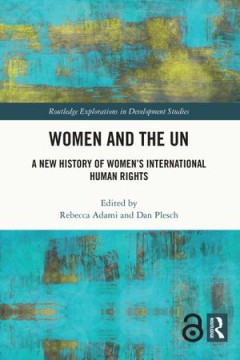Filter by

Sacred Mound, Holy Rings Silbury Hill and the West Kennet Palisade
The excavations at Silbury Hill in the late 1960s were broadcast to the world on television and generated a huge amount of excitement, but until now have not been published. This report gives a full account of the excavation and discusses the archaeological and environmental evidence from the tunnel, the ditch section and the cuttings on the top of the mound, as well as the radiocarbon dates. N…
- Edition
- -
- ISBN/ISSN
- 9781789256475
- Collation
- -
- Series Title
- -
- Call Number
- -

Women and the UN: A New History of Women's International Human Rights
This book provides a critical history of influential women in the United Nations and seeks to inspire empowerment with role models from bygone eras. The women whose voices this book presents helped shape UN conventions, declarations, and policies with relevance to the international human rights of women throughout the world today. From the founding of the UN and the Latin American feminist m…
- Edition
- -
- ISBN/ISSN
- 9780367478230
- Collation
- -
- Series Title
- -
- Call Number
- -

Democracy and Fake News: Information Manipulation and Post-Truth Politics
This book explores the challenges that disinformation, fake news, and post-truth politics pose to democracy from a multidisciplinary perspective. The authors analyse and interpret how the use of technology and social media as well as the emergence of new political narratives has been progressively changing the information landscape, undermining some of the pillars of democracy.The volume sheds …
- Edition
- -
- ISBN/ISSN
- 9781000286731
- Collation
- -
- Series Title
- -
- Call Number
- -

Europe under Pressure: The Development of the European Union under the Influe…
The past years were characterized by a massive influx of migrants crossing the Union's external borders seeking asylum. Illegal migration, exploitation of social welfare systems, foreign infiltration and the instrumentalization of religion condensed in terror attacks determine today's changed attitude towards foreigners, refugees and migrants and therefore strongly impact the current European p…
- Edition
- -
- ISBN/ISSN
- 9783828866881
- Collation
- -
- Series Title
- -
- Call Number
- -

The Distinction of Peace: A Social Analysis of Peacebuilding
Peacebuilding serves as a catch-all term to describe efforts by an array of international organizations, non-governmental organizations, and even agencies of foreign states to restore or construct a peaceful society in the wake— or even in the midst— of conflict. Despite this variety, practitioners consider themselves members of a global profession. In this study, Catherine Goetze investiga…
- Edition
- -
- ISBN/ISSN
- 9780472073412
- Collation
- -
- Series Title
- -
- Call Number
- -

Imperial Overstretch: Germany in Soviet Policy from Stalin to Gorbachev: An A…
The book is an analysis of the rise and fall of the Soviet empire in what, during the Cold War, was called ‘Eastern Europe'. Its central focus is the role played by the German problem in that process.
- Edition
- -
- ISBN/ISSN
- 9783848724529
- Collation
- -
- Series Title
- -
- Call Number
- -

European Union - The Second Founding: The Changing Rationale of European Inte…
The author is presenting a broadly structured study about the first fifty years of European integration, its geopolitical context and academic reflection. His study is based on the two-fold thesis that since a few years, the European Union is going through a process of its Second Founding while simultaneously changing its rationale.
- Edition
- -
- ISBN/ISSN
- 9783832935023
- Collation
- -
- Series Title
- -
- Call Number
- -

Europe - Against the Tide
Was sind die gegenwärtigen Herausforderungen der Europäischen Union? Wie reagiert sie auf internationale Veränderungen und Krisen? Und wie antwortet sie auf ihre Kritiker in den Mitgliedsstaaten? 16 Beiträge von internationalen Experten geben auf diese Fragen eine Antwort.
- Edition
- -
- ISBN/ISSN
- 9783848750719
- Collation
- -
- Series Title
- -
- Call Number
- -

Grazing Communities: Pastoralism on the Move and Biocultural Heritage Frictions
Pastoralism is a diffused and ancient form of human subsistence and probably one of the most studied by anthropologists at the crossroads between continuities and transformations. The present critical discourse on sustainable and responsible development implies a change of practices, a huge socio-economic transformation, and the return of new shepherds and herders in different European regions.…
- Edition
- -
- ISBN/ISSN
- 9781800736672
- Collation
- -
- Series Title
- -
- Call Number
- 301 GRA g

Conceptualizing Power in Dynamics of Securitization: Beyond State and Interna…
This volume addresses the ‘question of power’ in current constructivist securitisation studies. How can power relations that affect security and insecurity be analysed from both a transdisciplinary and historical point of view? The volume brings together contributions from history, art history, political science, sociology, cultural anthropology and law in order to determine the role of con…
- Edition
- -
- ISBN/ISSN
- 9783848751587
- Collation
- -
- Series Title
- -
- Call Number
- -
 Computer Science, Information & General Works
Computer Science, Information & General Works  Philosophy & Psychology
Philosophy & Psychology  Religion
Religion  Social Sciences
Social Sciences  Language
Language  Pure Science
Pure Science  Applied Sciences
Applied Sciences  Art & Recreation
Art & Recreation  Literature
Literature  History & Geography
History & Geography